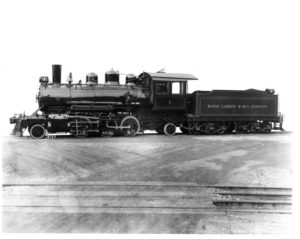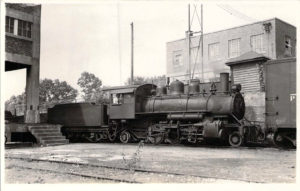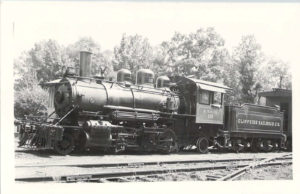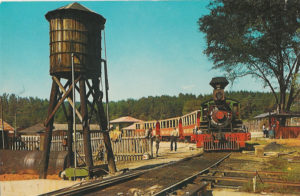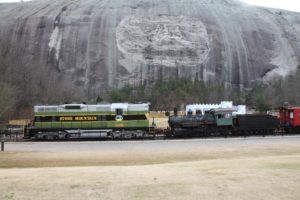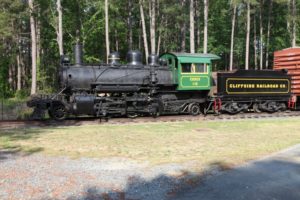Click here to go to the Restoral Project Website: https://locomotive110.com/
To Donate, click the Donate button above and select Network for Good and put 110 Restoration in the Designation field.
Article Written by David G Dick, New Hope Valley mechanical engineer. Edited for web by Mike MacLean.
History: Vulcan Iron Works built shop order #3150 in their Wilkes Barre, PA plant in July 1927. A light, low drivered 2-6-2 tender engine, it was one of the larger of the industrial type locomotives in which Vulcan specialized.
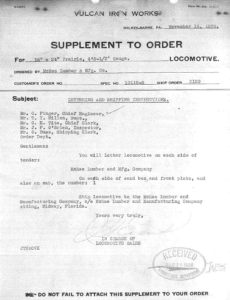
Supplement to original order for the locomotive from McRae Lumber and Manufacturing Company. November 1926.
It was built for a logging railroad tied to McRae Lumber and Manufacturing Company in Quincy, FL (now part of Rex Lumber Co) and worked for them from 1927 until 1930.
It was built for a logging railroad tied to McRae Lumber and Manufacturing Company in Quincy, FL (now part of Rex Lumber Co) and worked for them from 1927 until 1930.
As their #110, it worked in the company of a larger freight engine, 2-8-0 # 40, until it pulled the last steam train on that railroad on July 20, 1962.
Number 40 was sold to the New Hope and Ivyland RR in Pennsylvania, while #110 was retained in the event of the breakdown of Cliffside’s new diesel electric locomotive. The diesel proved reliable, and #110 was sold in 1963 to Echo Valley Park in Cleveland, SC and ran on the amusement park’s “Swamp Rabbit RR”.
#110 was sold to Stone Mountain Scenic Railroad in 1969. Being the smallest and slowest steam locomotive at Stone Mountain, it saw little use at the park. Stone Mountain has since ceased steam operations.
In 2012, the Stone Mountain Memorial Association donated the #110 to the North Carolina Railway Museum.
In February 2013, #110 was moved from her display location to Stone Mountain RR Shops for transport to Bonsal, NC. To see more pictures of the move, visit our Facebook page. Once at Bonsal, volunteers cleaned and repainted the #110 back to how she appeared on the Cliffside Railroad.
The New Hope Valley Railway welcomed Cliffside #110 back to NC in June of 2013 with a special ceremony. Special guests included dignitaries from the Remember Cliffside organization. One highlight of the day was the recreation of a photograph taken on the last run of the #110 at Cliffside.
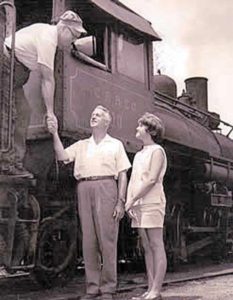
Photo from the Hazel Haynes Bridges Collection. W. Paul Bridges (center), president of Cliffside Railroad, wishes Conductor R. S. Biggerstaff well as #110, affectionally called “Old Puffer”, prepares to make her last run at Cliffside. Standing by is Bridges’ daughter Janice, 14, the company’s youngest stockholder. This photo appeared in The Forest City Courier in 1962.
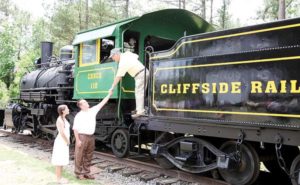
Courtesy Cliffside Historical Society. Phillip White, former president of the Cliffside Historical Society, recreates a photo that appeared in The Forest City Courier in 1962 before the final run of the #110 steam engine. Along with White is Paul Bridges, son of Janice Bridges Swing, and his daughter Nicola Bridges.
Tec
Technical: #110 is a 52 ton Light Prairie tender type steam locomotive of a style common to logging railroads in the flatter parts of the US. It is of the “modern” type, equipped with piston valves and outside Walschaert valve gear. With low 44” diameter drivers, and a total weight on drivers of 40 tons, it was made to ride easy on the lightweight temporary logging tracks and for low to moderate speed hauling medium sized loads. With a boiler pressure of 175 PSI and cylinders measuring 16X24 inches, it puts out a tractive force of 20,770 pounds. Originally a wood burner, it was converted to burn coal by Cliffside RR, then oil by Swamp Rabbit RR in 1964.
Cliffside Railroad: the 3.7 mile long, class III, Cliffside Railroad was built in 1905 to haul textiles from the Cliffside Cone Mills plant to its closest railroad junction at Ellenboro, NC, with the Seaboard Air Line Railroad (now part of CSX Transportation). Originally built as a three foot narrow gauge railroad, the Cliffside Railroad converted to Standard Gauge around 1914 so that it could easily be interchanged with common carriers. A true, colorful Southern shortline railroad, Cliffside was a famous tourist destination during the depression and 1940s for maintaining a brood of trained chickens on the #110’s tender, which were named for Cone Mills executives. Cliffside took over the Seaboard System’s Ellenboro branch to Cliffside Junction in 1984 when Seaboard wanted to abandon it, and expanded to 8.14 miles. The last train ran in 1987, and it was formally abandoned in 1992.

